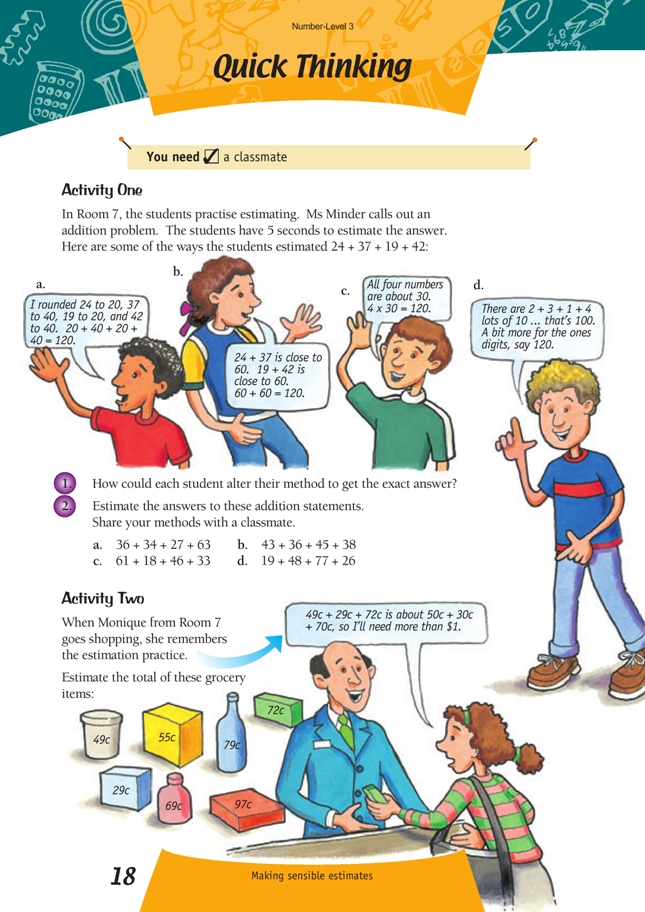This is a level 3 number activity from the Figure It Out series. It relates to Stage 6 of the Number Framework.
A PDF of the student activity is included.
Click on the image to enlarge it. Click again to close. Download PDF (241 KB)
use rounding to make sensible estimations for addition problems
A classmate
Activity One
Encourage students to develop mental strategies to solve number problems such as those in this activity. This is one of the most important things that teachers can do on a daily basis in the classroom to develop real mathematical thinking in students. Note that it is the developing and sharing of strategies for solving a question that is the important focus, not the number of questions solved mentally.
Think about ways of encouraging students to try some new strategies and to share successful ones with the class. A display showing “Strategy of the Week” may be encouraging for students.
“Question of the Week” could be another display, with the question being the one that was solved using the greatest variety of strategies over the week. Show the different strategies on the chart.
Challenging variations will include three- or four-digit addition, where students may group thousands or hundreds before tens and ones, for example, 4 268 + 862 + 4 349 + 721. “Two lots of 4 000 is 8 000. 200 + 800 is 1 000. 300 + 700 is another 1 000. So far, we have 10 000. Two sixties is 120, and four tens and two tens is another 60. That’s three sixties, which is 180. 8 + 2 makes 10, and so does 9 + 1, so the ones add up to 20. Now we have 10 000 and 200, that’s 10 200.”
More challenging contexts would involve operations other than addition as well as combinations of operations.
Activity Two
This activity applies rounding skills to estimation in a practical context.
Estimation is more realistic if there are three or more addends involved.
Other situations in which students could estimate total prices of items are:
• buying items that are in dollars only (two-digit, three-digit, or four-digit amounts)
• buying items that are in combinations of dollars and cents (three-digit or four-digit amounts).
You can use other contexts besides money, such as:
• sports: the total points scored by your favourite netball or rugby team over a whole season
• distances: the total distance travelled when you know the distance between each stop on the way
• time: the total number of minutes on a music CD when you know the length of each track.
Answers to Activities
Activity One
1. a. Adjust his rounding like this:
20 (+ 4) + 40 (– 3) + 20 (– 1) + 40 (+ 2)
= 120 (+ 4 – 3 – 1 + 2)
= 120 + 2
= 122
b. Both 24 + 37 and 19 + 42 are equal to 61.
61 + 61 = 122.
c. Adjust each number from 30. 24 is 30 – 6,
37 is 30 + 7, 19 is 30 – 11, 42 is 30 + 12.
120 – 6 + 7 – 11 + 12 = 122.
d. Calculate the exact total of the ones digit and then add the tens digit totals:
4 + 7 + 9 + 2 = 22. 22 + 100 = 122
2. Methods will vary. Likely estimates are:
a. 160 b. 160 or 170
c. 160 d. 170 or 180
(Students may allow for the fact that most of the numbers in b and d round up.)
Activity Two
Answers will vary. A likely estimate is $4.60.
